In biology, schooling fish are any group of fish that stay together and swim in the same direction in a coordinated manner.
Table of Contents
Factors for Swimming in a school
- Fish feels safer from predators when in a group
- Higher chance of finding food this way
- Easier to find a mate while in schools
- Higher hydrodynamic efficiency while swimming long distance
Why do Aquarists love schooling fish?
One thing that makes this type of fish particularly interesting for aquarists and others is the beauty of schooling species.
The way they move close to each other while keeping in perfect rhythm is incredible.
It is like they are being operated from one mind at the same time—all in your home aquarium!
Whether you keep them alone (Really not advisable for a schooling fish) or with other fish species, they will surely entertain you and boost the activity in your tank.
Easy-To-Maintain Schooling Fish
Here are some of the greatest and easiest schooling fish you can keep in your aquarium:
Rummy-nose tetra (Hemigrammus bleheri)
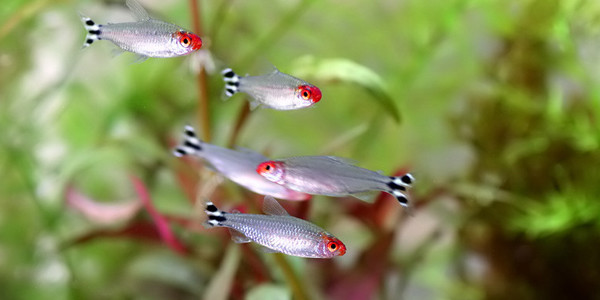
This fish got its name from the red blushing mark that stretches across its mouth and face.
They are one of the most popular tightly schooling fish and are a great sight to watch in any aquarium.
They lack in color in comparison with other types of tetras, but their silver body and black tail make them just as beautiful.
They do best in schools, but they also hide alone in appropriate spots occasionally.
Keep in mind these fish are highly sensitive to temperature and pH fluctuations.
The best water temperature for rummy-nose tetras is anywhere between 72-77⁰ Fahrenheit with a pH of 5.5 – 7.0.
White cloud mountain minnow (Tanichthys albonubes)
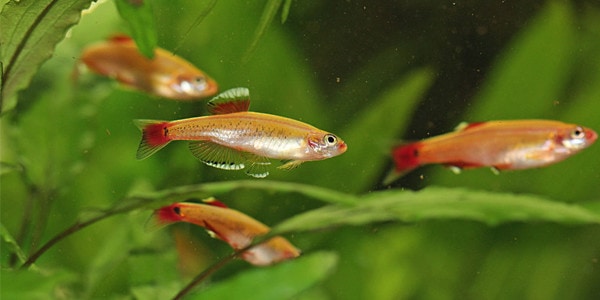
This fish is often underestimated as a possible easy schooling fish for a freshwater aquarium.
They are hardy, incredibly active, and colorful.
They are also easy to breed, which is good for beginners.
The chief liability of this fish is their small size—only 1.5 inches.
White cloud mountain minnows prefer water temperatures ranging from 65-75⁰ Fahrenheit.
Experts believe they can withstand temperatures anywhere between 50-90⁰ Fahrenheit for short periods with slightly soft water pH 6.0 to 8.0.
Cardinal tetra (Paracheirodon axelrodi)
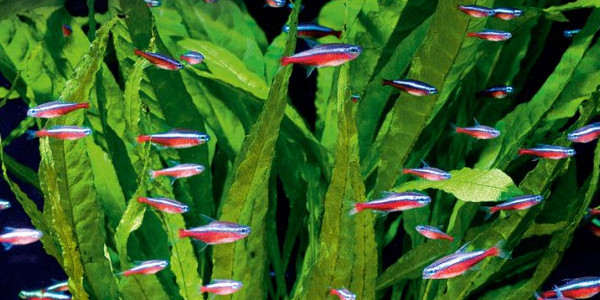
These easy schooling fish are far too beautiful to pass on when choosing your schooling freshwater aquarium fish.
It has a glowing, bright blue stripe across the entire length of their body and another red stripe just under the blue one.
Their natural habitat is in Brazil where they are caught wild and exported to other parts of the world.
They are small in size (they grow up to 1.5 inches) and are great to watch while swimming.
Being schooling fish, cardinal tetras do best in groups of at least six.
The ideal water temperature for cardinal tetras is between 73-81⁰ Fahrenheit with a preferable pH is from 5.5 – 7.5.
Harlequin rasbora (Rasbora heteromorpha)
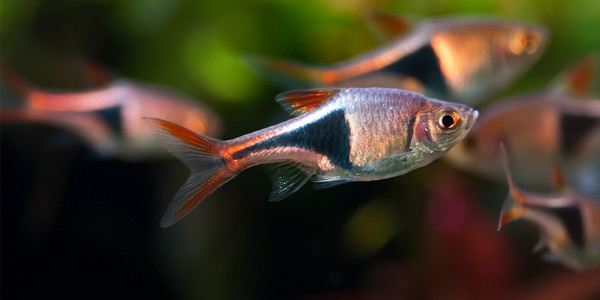
Another popular easy schooling fish is the Harlequin Rasbora.
The black triangular patch found near the fin easily distinguishes these fish.
They are mostly kept in groups as they enjoy the company of other fish.
Together they form tight schools and are always on the move—a beautiful sight in any aquarium setup.
They tend to keep themselves at the top of the tank while swimming in circles with unmatched elegance.
They are considered to be small fish, given the fact that they reach 2 inches at maximum.
Beautiful, lively, small, and easy to keep makes these fish an absolute favorite for many aquarists around the world.
Their hardiness and simplicity makes them a good choice for beginners, too.
They like temperatures between 73-85⁰ Fahrenheit and a pH range from 6.0 to 6.7.
Cherry barb (Puntius titteya)
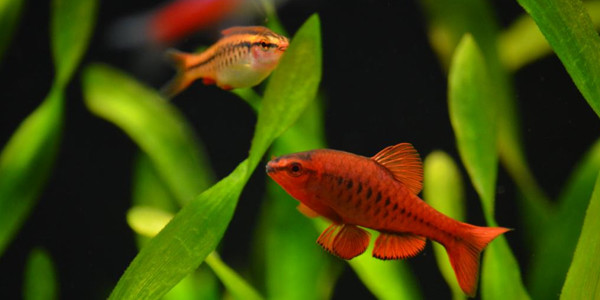
Cherry barb originates from its natural habitat in tropical waters in Sri Lanka.
The body of these fish is silver/black with a golden horizontal stripe that stretches across the body.
Cherry barb got its name because males turn deep red during spawning times, so their color resembles the one of a cherry.
It is a peaceful, yet hardy species and it does not take much to learn how to care for them.
They tolerate a wide range of water parameters, which can be great if you are a beginner aquarist.
Cherry barbs are small fish as they grow to 2 inches at most.
They do best when kept in schools of 6 and more fish.
The ideal temperature for cherry barbs is anywhere from 73-80⁰ Fahrenheit and pH range between 6.0 – 7.5.
Zebra danio minnow (Danio rerio)
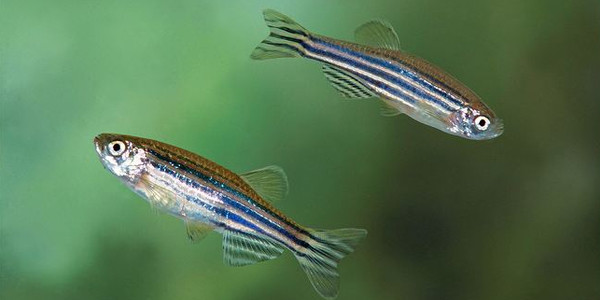
Zebra danios are another easy schooling fish and they are easily recognizable due to their striped zebra-like pattern.
They are most often gold or silver with blue or purple stripes stretching all across their body.
They dwell close to the surface and are extremely active swimmers which makes them a beautiful sight to watch while in action.
This fish is both inexpensive and hardy, which makes it a great fish for beginners.
Today they are selectively bred all across the world, so there are plenty of variations to choose from.
Temperatures for zebra danios range between 64-75⁰ Fahrenheit.
They prefer slightly acidic water as the ideal pH for their keeping is anywhere from 6.0-7-0.
Neon Tetra (Paracheirodon innesi)
When it comes to schooling fish, there’s nothing that beats the types of tetras. The neon tetra is one of the most popular. They are easy to maintain, have a vibrant appearance, and are ideal for freshwater aquariums.
Since they are so small, you can add 10-12 neon tetras to a tank. Also, they are very adaptable and can thrive in community tanks. They are often known as the jewels of the tank and are quite hardy and flexible. They grow up to an inch in length and come with a pop of color.
This is also why they don’t work well with larger fish. If you are keeping them in a community tank, the same species or smaller fish are ideal. They are omnivores and will rely on flakes and pellets alike. Also, their water should be between 72 to 79 degrees Fahrenheit.
| Scientific Name | Paracheirodon innesi |
| Experience level | Easy to intermediate |
| Size | Up to 1 inch |
| KH (Carbonate hardness) | 1-2 dKH |
| Minimum Tank Size | 10-20 gallons |
Black Skirt Tetra (Gymnocorymbus ternetzi)
Another type of tetra that is ideal for schooling fish is the Black Skirt Tetra. They are a little larger and have a flared anal fin that gives their name. The fish has a silver body with black spots and fins that give them a mysterious appearance. The entire body of the fish is designed with black stripes from the top to the base.
They are quite peaceful and like to keep to themselves. They are bottom feeders, so pellets work ideal for them. Also, when keeping them in a tank, make sure they live in a group of 6-7. They are freshwater fish and need warmer water temperatures.
The fish is native to Bolivia and Brazil and needs vegetation in the tank. They are a good addition to community tanks of 15 gallons and more capacity. However, avoid keeping them with larger fish since they can feel threatened and under stress.
| Scientific Name | Gymnocorymbus ternetzi |
| Experience level | Easy to intermediate |
| Size | Up to 2 inches |
| KH (Carbonate hardness) | 4-8 KH |
| Minimum Tank Size | 15 gallons |
Otocinclus Catfish (Otocinclus)
These are commonly known as dwarf suckers and are algae-eating species. They are perfect for community tanks that produce algae at an alarming rate. So, if you want to keep your tank clean and without any algae remnant, this fish takes care of the same.
The only issue with this species is its size. They can reach up to 2 inches and often mimic the appearance of Plecostomus. However, they are quite different in their personality from common pleco. Not only do they live in schools, but they are also quite peaceful too.
They have a miniature appearance and work well in the same-species tank. When buying them, buy them in groups of 6-7. Also, be very mindful while choosing their tank mates. Any kind of larger fish can be a threat to them.
The fish has a small sucker mouth, hence the common name. They have a spotted appearance with black spots all through the body. Besides the prominent black, you can also find green, brown, and even grey hints on the body.
| Scientific Name | Otocinclus |
| Experience level | Easy |
| Size | 1-2 inches |
| KH (Carbonate hardness) | 6-10 KH |
| Minimum Tank Size | 10 gallons |
Hatchetfish (Sternoptychinae)
Besides the unique appearance, Hatchetfish is a freshwater fish species. It is found in the deep waters and has an elongated appearance like a hatchet, hence the name. The exterior of their body is covered in silver scales, and the bigger ones have splashes of brown and green on the body.
They are peaceful and won’t get territorial or aggressive if not provoked. So, when pairing them in community tanks, you need to find a species that will work accordingly. Also, the fish requires soft water, so you need to be mindful of that.
The care and maintenance of this species are a little difficult. However, that doesn’t mean you have to compromise on your sanity. Once you get the hang of the process, it is a smooth ride from there.
Since they are surface feeders, flakes work the best for their feeding. Also, they are quite jumpy and will try to jump out of the tank. So, make sure you keep the aquarium lid closed at all times.
| Scientific Name | Sternoptychinae |
| Experience level | Intermediate to advanced |
| Size | 2 inches |
| KH (Carbonate hardness) | 2-14 dGH |
| Minimum Tank Size | 30 gallons |
Tiger Barb (Puntigrus tetrazona)
The appearance of yellow with black stripes along the length of their body gives them their name. It is a very popular schooling fish that is easy to care for. Also, they are very active and like to move around the tank at high speed. So, providing them with enough space around the tank is necessary.
They have a very sporty personality, hence a popular species among hobbyists. They aren’t the most peaceful, so finding them suitable tank mates can be a hassle. They depict signs of semi-aggression when they don’t find favorable living conditions.
Tiger barb should be kept in a school of 5-6 for a comfortable living. They are native to the tropical regions, hence need warmer temperatures of the water. The black stripes over the yellow scales run down vertically through the body, hence the name.
Since they are fin nippers, never pair them in a tank with fish species with longer or flowing fins.
| Scientific Name | Puntigrus tetrazona |
| Experience level | Easy to intermediate |
| Size | 2-3 inches |
| KH (Carbonate hardness) | 4-10 KH |
| Minimum Tank Size | 30 gallons |
Clown Loaches (Chromobotia macracanthus)
Amidst all the options we have mentioned, Clown loach is hands down the most unique of them all. Not just in terms of appearance but also their characteristics and personality. They have a striped and tapered body with a long nose. The sensing barbels keep them alert and away from danger.
Although the species starts small in the tank, they can grow up to 8 inches. So, pair them with the right tankmates. Also, since they are schooling fish, it is important to look out for compatible ones.
They are very peaceful and like to hide away under the hiding spots. So, you won’t find them disturbing the other species in the tank. They do well in same-species tanks if you aren’t sure about community tanks.
The prominent orange-colored appearance with the V-shaped stripes on the body makes them stand out in the aquarium. Also, they are bottom dwellers, so pellets work the best for their feeding.
| Scientific Name | Chromobotia macracanthus |
| Experience level | Easy to intermediate |
| Size | 7-12 inches |
| KH (Carbonate hardness) | 5-15 dH |
| Minimum Tank Size | 100+ gallons |
Platy (Xiphophorus maculatus)
One of the easiest aquarium fish to care for is Platy. It is a small freshwater fish with a peaceful temperament. They are native to South Asian countries and stand out because of their vibrant orange colors.
They cohabitate well in the community tanks. However, make sure you pair them with similar size fish with a peaceful temperament. Since they are so small, adding them to a tank with big fish will put them under stress. Tetras and mollies make great tankmates for them.
The fish likes to stay in groups of 6-8 and are found in different colors. The orange ones are the most common in the market. However, there are ones with silver and black scales with specks of red on the body.
They don’t like to stay alone in a tank. So, even if they are kept in groups of 2-3, they shouldn’t be alone. They need social interaction to stay healthy.
| Scientific Name | Xiphophorus maculatus |
| Experience level | Easy |
| Size | 2-3 inches |
| KH (Carbonate hardness) | 10-28 dGH |
| Minimum Tank Size | 10+ gallons |
Pygmy Cory (Corydoras pygmaeus)
If you are done housing the easily accessible and mainstream fish species, try Pygmy Cory. It is a type of catfish and is quite small in size. They make amazing schoolish fish and have a very cute appearance when added to freshwater tanks.
The fish doesn’t grow very large, unlike the staple catfish. It has a silver body with deep whiskers. The scale on the body is very shiny and becomes iridescent under the light. They have a prominent black stripe running down the length of the body.
Since they are schooling fish, they ideally perform well in groups of 6-8. They don’t work well when kept in isolation and will become skittish eventually. Also, they are bottle dwellers and like to spend most of their time there. So, you want to fill the tank with a smooth substrate to prevent injuries.
Pygmies are very shy. So, when you are keeping them in community tanks, avoid larger fish. The last thing you want is to put them under stress. Dwarf fish, shrimps, snails make great tank mates.
| Scientific Name | Corydoras pygmaeus |
| Experience level | Easy |
| Size | 1.5 to 3.5 inches |
| KH (Carbonate hardness) | 6-10 dKH |
| Minimum Tank Size | 10+ gallons |
Scissortail Rasboras (Rasbora trilineata)
Beginner aquarists with little experience will appreciate working with this fish species. The type of Rasbora is peaceful, easy to handle, and very tiny. They have a forked tail, hence the name because it mimics the appearance of scissors.
The unique trait of this fish is its swimming. They flap their tail in a way during swimming that mimics the appearance of a scissor. Also, they are quite fast swimmers and like to stay active throughout the day.
They are one of the most popular schooling fish that works well in community tanks too. When buying, make sure you buy them in groups of 6-8. The silver appearance on the exterior makes them stand out in the tank.
Their peaceful nature makes them good tankmates to any fish of similar size. So, if your community tank has species like cories, danios, other rasboras, the scissortail will work well in that.
| Scientific Name | Rasbora trilineata |
| Experience level | Easy to intermediate |
| Size | Up to 4 inches |
| KH (Carbonate hardness) | 6-8 dKH |
| Minimum Tank Size | 20 gallons |
FAQs
Which fish are schooling fish?
Schooling fish are the ones that swim in the same direction and coordinated manner in the tank. Several species are schooling fish, including tetras, barbs, rasboras, certain catfish species, etc.
What is a good schooling fish?
While it is hard to pinpoint just one, we have our top five picks for best schooling fish. They include cardinal tetras, silvertip tetra, ember tetra, rasbora, and zebrafish.
What is schooling behavior for fish?
Schooling behavior in a tank is a predominant social behavior. In this, the fish come and stay together in groups to swim in one direction. This behavior is also often termed aggregation.
Why is schooling important for fish?
Besides the social importance and safety, schooling improves the chances of breeding and ensures successful reproduction after finding a potential mate. Schooling also provides the fish with a sense of security and belonging.
Why is it called a school of fish?
It is called a school of fish because they aggregate together to swim in similar patterns, directions, and manners. They mimic their movements and follow a set pattern.
What’s the difference between a shoal and a school of fish?
Shoaling is when the fish species just stay together in one spot of the tank for social reasons. Schooling is when the fish species swim together in the same direction and the same strides.
Why do fish swim in shoals?
Shoaling has several benefits for the fish. It helps them find a potential mate. It helps provide security and safety from predators. Shoaling is also ideal for finding food in the tank.
How do schooling fish communicate?
Schools move in a very organized and disciplined matter. Their movement is polarized in certain directions, and they often mimic their neighbor’s speed too. So, if the neighbor moves in circles, the one besides will mimic that and follow suit.
Lastly…
Schooling fish are a wonderful addition to any tank as they bring life and excitement to every aquarium.
If you are planning to have a school of fish in your tank, do consider the size of your tank to determine the number of fish you can have.
You do not want to overpopulate your tank in the process of wanting a school of fish.

6 thoughts on “Easy Schooling Fish”
I’m getting away from cichlids and going to Startup a 110 gallon Community tank and I want at least two to three schools of fish and others do you have any ideas?
Wow, well all I’ve gotta say is that your aoptions are open; just pick relatively peaceful fish for the community! 🙂
I want to put together a freshwater mini aquarium and I was wondering, since my house usually stays at 72 degrees what can I do to make sure the tank is the right temperature? ( I’m a beginner so I’m just trying to educate myself on the subject as much as possible. I’m really coming in with no scientific knowledge in this field)
You would still want a heater just in case. Heaters are normally pretty cheap (like $20) even for my 29 gallon. But read reviews to avoid getting a faulty heater. Just remember you get what you pay for…
Your heater will make sure your tank is the perfect temperature. It will turn off when the temperature gets too high. It will turn on when it’s too low.
I have 6 Inch tin foil barb in my aquarium I want to add a school or two which fish do you recommend.